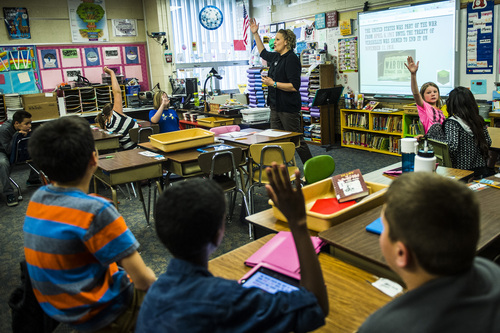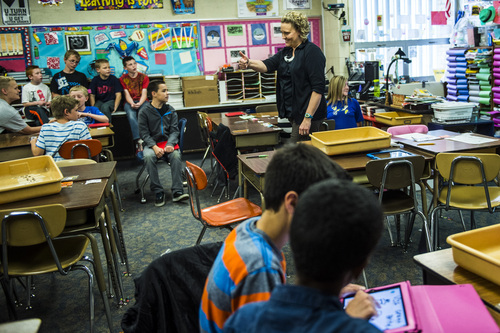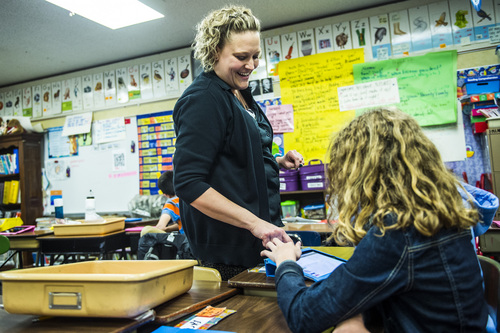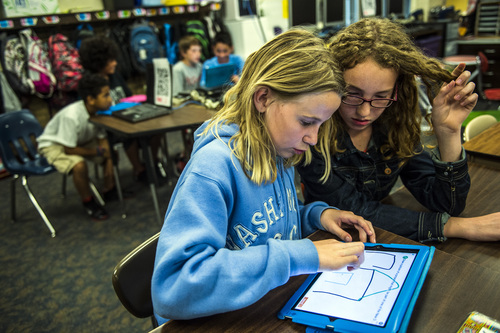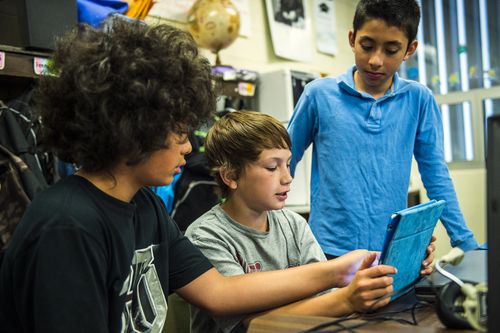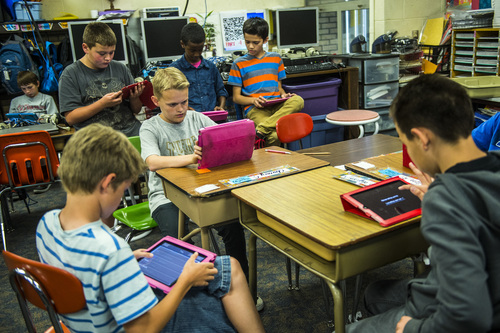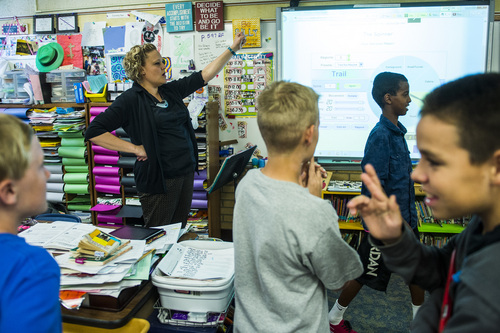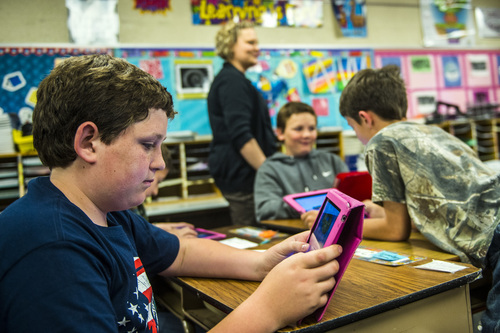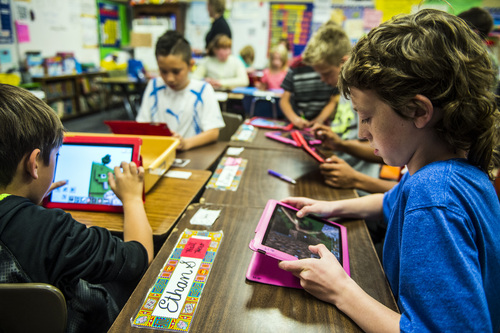This is an archived article that was published on sltrib.com in 2014, and information in the article may be outdated. It is provided only for personal research purposes and may not be reprinted.
Taylorsville • Minecraft explorers worldwide excavate sand to smelt into glass, diamonds to hone into swords and redstone to power millions of digital creations.
Amber Palmer's fifth-graders visit the Minecraft universe to dig into U.S. history.
At the beginning of the school year, the Bennion Elementary students learned about explorers and land charters, which they had to request from Queen Palmer to begin their virtual building on iPads. (Later, the queen's stiff taxes provoked a revolt.)
Students formed their own states, debated whether to have slaves, moved westward, endured insect infestations, fires and other natural disasters, and built factories at the beginning of the Industrial Revolution.
By the time they were creating Minecraft houses with cubes representing gold and diamonds, as they studied the "roaring" 1920s, they knew the decadence could not last.
"They have had enough experience," Palmer says, "to know that there are ups and downs throughout history."
Her savvy in using programs such as Minecraft, Tellagamis, iMovie, MadLips, and S'Cool earned her one of five KUED-The Salt Lake Tribune Teacher Innovation Awards. She and the others will be profiled in a half-hour program Thursday at 7 p.m. on KUED.
Minecraft, she says, is a great tool for creativity and collaboration as she teaches social studies and language arts at the Taylorsville school.
"It's a way for students to process understanding," she says. "They are the programmer. Their game is only as smart as they are."
—
'How to attack differently' • Video games are a subset of the educational software that is spreading fast into the nation's classrooms as schools buy laptops, tablets and Chromebooks — and get wired for Internet access.
But digital games are still fairly rare in Utah's classrooms.
"It's a trend that's forever launching," says Rob Bentley, a former teacher who now works for the Utah Education Network, teaching teachers to use technology.
Bentley wrote his own video games to teach Spanish when he first taught junior high in 2001 and has been hearing about an expected surge in game use since about 2005.
Rick Gaisford, education-technology specialist at the Utah Office of Education, says skeptics wonder whether games can truly be educational.
Universities worldwide are researching the topic now, and as research substantiates that games can teach problem solving and critical thinking, more teachers likely will adopt them, he predicts.
Watching his own sons play video games convinced Gaisford that there is some value.
The data-collecting potential in games is great; teachers can learn what students do and don't know, he says.
And while failure on a pencil-and-paper quiz may cause a discouraged student to tune out, failure at a video game is to be expected.
"Kids in these games, they rethink ... how to attack differently. Or they go online and research it," Gaisford says. "It would be nice if we could have that happening more often in education."
Nonetheless, he says, "The debate [over games] is still ongoing. The jury is still out."
—
'Power up' • Jessica Lindl, a general manager at GlassLab, says there is already exponential growth in the use of video games in classrooms.
But, she says, the supply of effective games is limited. "Teachers really, really want these games, but they feel there are not enough."
GlassLab is a California nonprofit that turns popular video games into educational games. It turned Electronic Arts' SimCity simulator into SimCityEdu and recently released a language-arts game, Mars Generation One, a venture with NASA.
A good game does more than help students memorize facts or provide rewards for achievement. Learning, she says, has to be its own reward in the game.
UEN's Bentley says educational games need to leverage the addictive aspect of games — the need to "power up or level up."
While it's not good when a 22-year-old stays up all night playing games and sleeps all day, "the idea is it's so addictive and so fun, it's taking over their life," Bentley says. "What if we could help our students be addicted to learning?"
—
Engagement 'makes it work' • Emorie Mortimer, 10, says she was wary when Palmer told students they were going to play Minecraft.
"At first I thought it was off-topic," Mortimer says. "Then I realized it could be creative and be on topic."
The students use their iPads during class to peruse information Palmer points them to, via her Nearpod multimedia presentations or on the Internet.
On a recent day, they looked at Depression-era propaganda posters during her lecture.
For five or 10 minutes at the end of each social studies class, the students log into Minecraft and build their teams' worlds to deal with whatever historical circumstance Palmer throws their way. (The game has been stripped of zombies for use in schools.)
To cement their understanding of the Depression's economic desperation — unemployment was at 25 percent — Palmer teaches the 10- and 11-year-olds about the Civilian Conservation Corps, which provided jobs for millions of young men. Some 2,000 built trails, parking areas, campgrounds and buildings at Zion National Park from 1933 to 1942.
Students spin an electronic dial on the Smart Board to determine what their teams will create next.
Will it be a trail? A cabin? An amphitheater? A road?
"We remember it by putting it into Minecraft," explains April Murillo, 10, who spins "bridge."
Palmer also uses Minecraft in a language-arts class, where students are studying the book "Journey to Topaz" by Yoshiko Uchida, a survivor of the World War II-era Japanese-American internment camp in west-central Utah.
Those students are re-creating the camp.
Learning with technology is more challenging for the students and for teachers, Palmer says. It takes a lot of time to weave curriculum into video presentations, for instance.
She is excited by the potential, however, for students to experience collaboration and learn to discern the good information from the bad on the Internet.
"Technology is a tool," Palmer says. "It's the human element and engagement that makes it work."
kmoulton@sltrib.com Twitter: @KristenMoulton —
Airing Thursday
o Five Utah teachers have been selected for KUED-The Salt Lake Tribune Teacher Innovation Awards, which celebrate their creative use of technology in classrooms.
The awards were given in the categories of arts, math, language arts, science and social studies.
The winners are being profiled in a continuing Tribune series this week and in a half-hour documentary airing Thursday at 7 p.m. on KUED-Channel 7. —
TribTalk: Celebrating innovation
As digital devices increasingly appear in Utah classrooms, the challenge is using them effectively in teaching.
On Tuesday at 12:15 p.m., Copper Mountain Middle School teacher Tami Ewell — a KUED-The Salt Lake Tribune Teacher Innovation Award winner — and Tribune education reporter Lisa Schencker will join Jennifer Napier-Pearce to talk about technology in the classroom.
You can join the discussion by sending questions and comments to the hashtag #TribTalk on Twitter and Google+.


